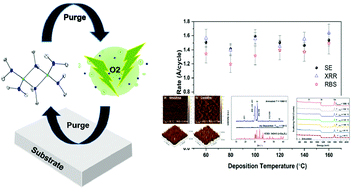Low temperature growth of gallium oxide thin films via plasma enhanced atomic layer deposition†
Abstract
Herein we describe an efficient low temperature (60–160 °C) plasma enhanced atomic layer deposition (PEALD) process for gallium oxide (Ga2O3) thin films using hexakis(dimethylamido)digallium [Ga(NMe2)3]2 with oxygen (O2) plasma on Si(100). The use of O2 plasma was found to have a significant improvement on the growth rate and deposition temperature when compared to former Ga2O3 processes. The process yielded the second highest growth rates (1.5 Å per cycle) in terms of Ga2O3 ALD and the lowest temperature to date for the ALD growth of Ga2O3 and typical ALD characteristics were determined. From in situ quartz crystal microbalance (QCM) studies and ex situ ellipsometry measurements, it was deduced that the process is initially substrate-inhibited. Complementary analytical techniques were employed to investigate the crystallinity (grazing-incidence X-ray diffraction), composition (Rutherford backscattering analysis/nuclear reaction analysis/X-ray photoelectron spectroscopy), morphology (X-ray reflectivity/atomic force microscopy) which revealed the formation of amorphous, homogeneous and nearly stoichiometric Ga2O3 thin films of high purity (carbon and nitrogen <2 at.%) under optimised process conditions. Tauc plots obtained via UV-Vis spectroscopy yielded a band gap of 4.9 eV and the transmittance values were more than 80%. Upon annealing at 1000 °C, the transformation to oxygen rich polycrystalline β-gallium oxide took place, which also resulted in the densification and roughening of the layer, accompanied by a slight reduction in the band gap. This work outlines a fast and efficient method for the low temperature ALD growth of Ga2O3 thin films and provides the means to deposit Ga2O3 upon thermally sensitive polymers like polyethylene terephthalate.



 Please wait while we load your content...
Please wait while we load your content...